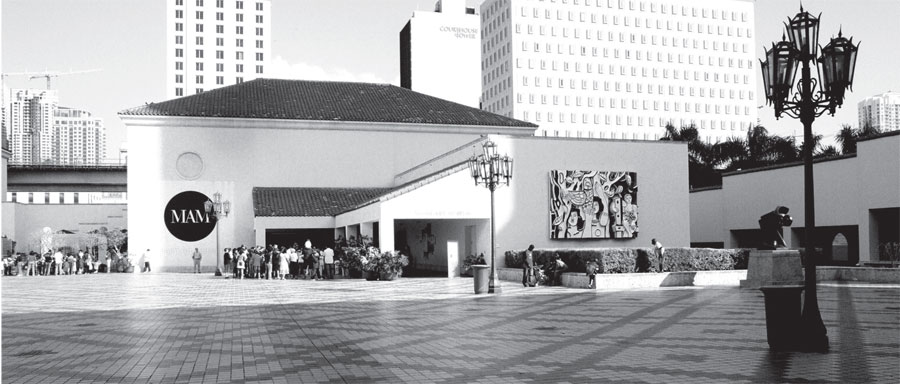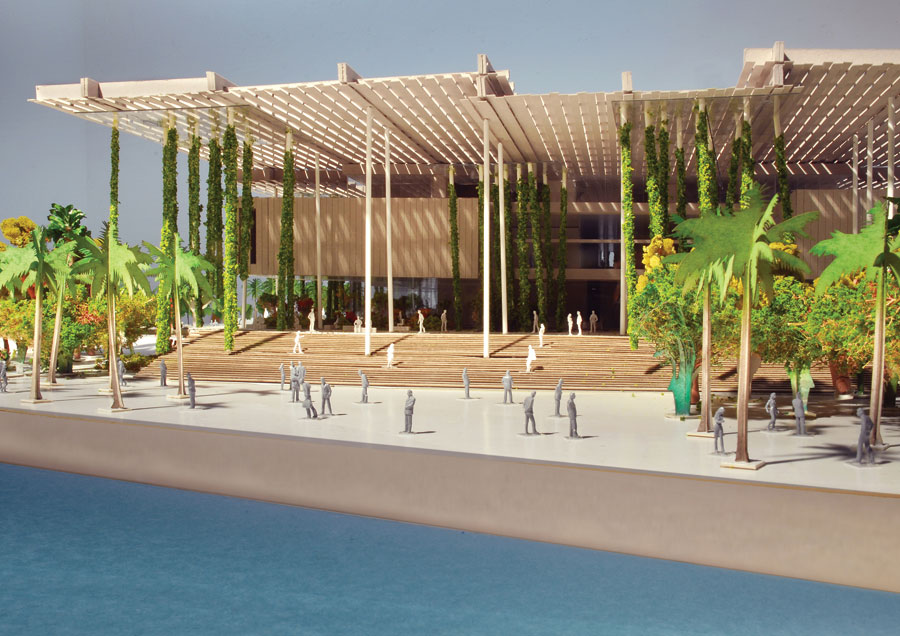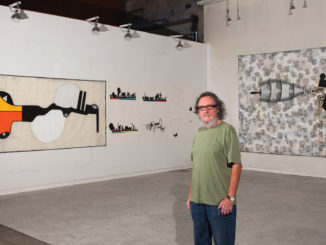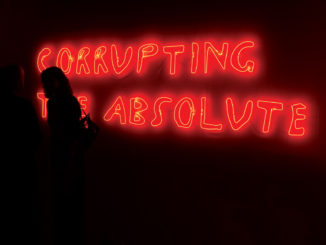
The showing of contemporary art in Miami is real evidence of this area’s artistic maturation and its need to define itself as more than just a vacation spot. While the Miami Art Museum is one of the youngest such organizations here, its collections have been expanding and show the dedication of both the museum and its patrons to developing visual art in South Florida. Enlarging these collections is proof also of Miami’s growing international importance, its diversity and its position as a gateway to the Americas.
As Miami Art Museum (MAM), it’s only twelve years old, but in its previous incarnation, from 1984 to 1996, it was the Center for Fine Arts (CFA), located next to the Main Library at 101 Flagler Street in downtown. It began as a private/public alliance with some taxpayer funding, but at least fifty percent of its budget came from non-taxpayer sources such as individuals, businesses and foundations. Unlike other museums – the Bass Museum on Miami Beach and the Lowe Art Museum in Coral Gables, for example – the CFA did not have permanent exhibitions of its own and mounted only temporary showings. The reason can be traced back, in part, to the site it still inhabits, which at only 36,000 square feet was never meant to maintain any permanent collection.
Realizing how limiting this was, a completely different tack was taken starting in 1995: the name change was simply the least of it. The museum’s curators would start buying pieces to make whole, encompassing collections. Furthermore, they would concentrate on modern and contemporary art, focusing on artists of the western hemisphere. At first glance, some might consider that quite a gamble: visual art can be difficult enough to champion, but modern and contemporary art could be twice as difficult. The decision, however, was made from a pragmatic standpoint: South Florida, at least at this time, does not have a sizable amount of older pieces. Private collections in Miami seem to be geared more toward 20th Century works, particularly those that are post-World War II.
Suzanne Delehanty, the Founding Director, was in charge at that time, and under her curatorship the collection increased from virtually nothing to nearly 300 pieces. The initial collection began with “Dream Collection: Gifts and just a few hidden desires”, which opened in October 1996: there were fourteen gifts in all, including a rare Adolph Gottlieb “pictograph” painting. It may have been the inaugural lot, but already artists who had achieved either national or international standing were represented, including Robert Rauschenberg, Helen Frankenthaler, Louise Nevelson and James Rosenquist. Also included were artists who had either a Florida or a Miami connection, including Carlos Alfonzo, José Bedia and Barbara Neijna.

The second Dream Collection exhibition opened in September 1997 and showcased still more purchases, including Lorna Simpson’s Still (1996). In addition, Morris Louis’s Beth Shin (1958) and Frank Stella’s Chodorów II (1971) were obtained that same year from patrons Mimi and Bud Floback, who gave them to the museum.
Since that time, MAM has made great strides in growing its collections. Between 1996 and 2003, approximately 150 works were either purchased or given to the organization. After an announcement was made in 2004 that plans were coming together for a new, bigger MAM, donations increased appreciably. What started as a museum with nothing to call its own now has over 600 works – many by famous, respected artists.
Another source of impressive gifts for MAM is Dorothy and Herbert Vogel. The Vogels, a nondescript, elderly couple in New York, have amassed in their apartment a spectacular personal collection noted for its depth and richness. They started collecting in the 1960s and, due to their modest salaries as public employees, focused on smaller pieces by newer artists, many of whom found fame later on. They kept purchasing works over the years to the point where they had put together one of the nation’s finest collections of minimalist and conceptual art.
The Vogels have noted happily that their collection always threatens to overwhelm their personal living quarters, so they have taken to giving pieces away. They gave MAM an impressive collection that showcases twenty-six artists, including Robert Barry, Lucio Pozzi and Sylvia Plimack Mangold. A silkscreen, two sculptures (by Richard Nonas), five works on canvas, eight mixed media pieces, and thirty-four works on paper comprise MAM’s fifty-piece Vogel Collection.
It’s been noted that the Vogels focused on acquiring drawings; this makes their collection that much more unique. Not only are their pieces distinctive, they are great tools for art studies. This brings into play one of MAM’s most impressive successes: continuing art education, particularly in the time of budget cuts.
Terence Riley, late of New York’s Museum of Modern Art, where he was its Chief Curator of Architecture and Design, replaced Delehanty in January 2006 and is now a consultant to the organization. Understanding that MAM’s mission was “to exhibit, collect, preserve and interpret international art,” his team kept MAM focused on enlightening its visitors. The museum has an extensive educational-outreach program called “MAM & Schools.” Offered are different visits that bring the artwork and the artists to students and teachers.
MAM has the largest museum-based art-education program in the county and operates the largest art program outside of the Miami-Dade County Public Schools system. During the 2008-09 school year, MAM grew its classroom-based audience by thirty percent, serving 10,800 patrons via no-cost programs. These included free bus rides to visit the museum, free guided tours for students and teachers, free visits to the classroom, free support materials for educators at Teacher Workshops and more. In 2008-09, MAM eliminated admissions fees for students and bore the costs of school buses. Educators had made it clear that legislative budget cuts had virtually wiped out any money for field trips. For students who cannot leave school grounds, MAM brings teaching materials into the classroom. Pupils who show real interest in modern art can have talks arranged between themselves and artists or curators. MAM’s exhibition schedule also includes Scholastic Art Awards to students who show exceptional talent. In conjunction with the public-schools system, the finest student works are showcased by the museum with the winners continuing on to national-level competition.
Delehanty noted years ago that “Miami remains the only major city in the United States without a world-class art museum.” If Miami were to achieve notable status in that field, it would have to get serious about obtaining and creating art and showcasing it properly. Finally, the City of Miami Commission took note, and in 2004 voters approved a $100 million bond issue to help fund Museum Park Miami, a huge public-works project that will allow MAM and the Miami Science Museum to have new, enlarged facilities on a premier, twenty-nine-acre parcel of land fronting Biscayne Bay known as Bicentennial Park. MAM determined it would raise its own, private funds in the amount of $120 million.
Hired to design the new museum were celebrated Swiss architects Jacques Herzog and Pierre de Meuron, the Pritzker Architecture Prize winners who created the Beijing National Stadium – “the Bird’s Nest” – for the 2008 Summer Olympics and redesigned the Bankside power plant on the Thames River into a new Gallery of Modern Art for London’s Tate Museum. Herzog and de Meuron are noted for their use of unusual techniques and new materials, and they put that sensibility to use for the new MAM, which will break ground in mid-2010. (The opening is slated for 2013.)
They envisioned a 125,000-square-foot, three-story structure surrounded by the greenery of a new and improved Bicentennial Park. Their design has the building bringing the park into the museum itself and features a perforated canopy that allows sunlight and fresh air to pass through to a shaded plaza below it. As visitors move from the park to the plaza, greeting them will be trees, floating columns and statuary. One design critic likened it to walking through a lush forest or garden.
On a more practical side, MAM and the Miami Science Museum are projected to attract at least 1.2 million visitors yearly, create 1,700 jobs and contribute $2 billion to the local economy in the first ten years alone. In securing this new site, MAM must be considered a nexus connecting the financial and artistic communities of South Florida to each other.
It’s a complete turnaround for MAM, from being the museum that was always cramped for space to being one of the finest museums in South Florida and also situated on prime waterfront property. In many ways, the fortunes of MAM run parallel to those of Miami, which, with all the improvements in its artistic offerings, truly can be considered a city of world-class stature.



Be the first to comment